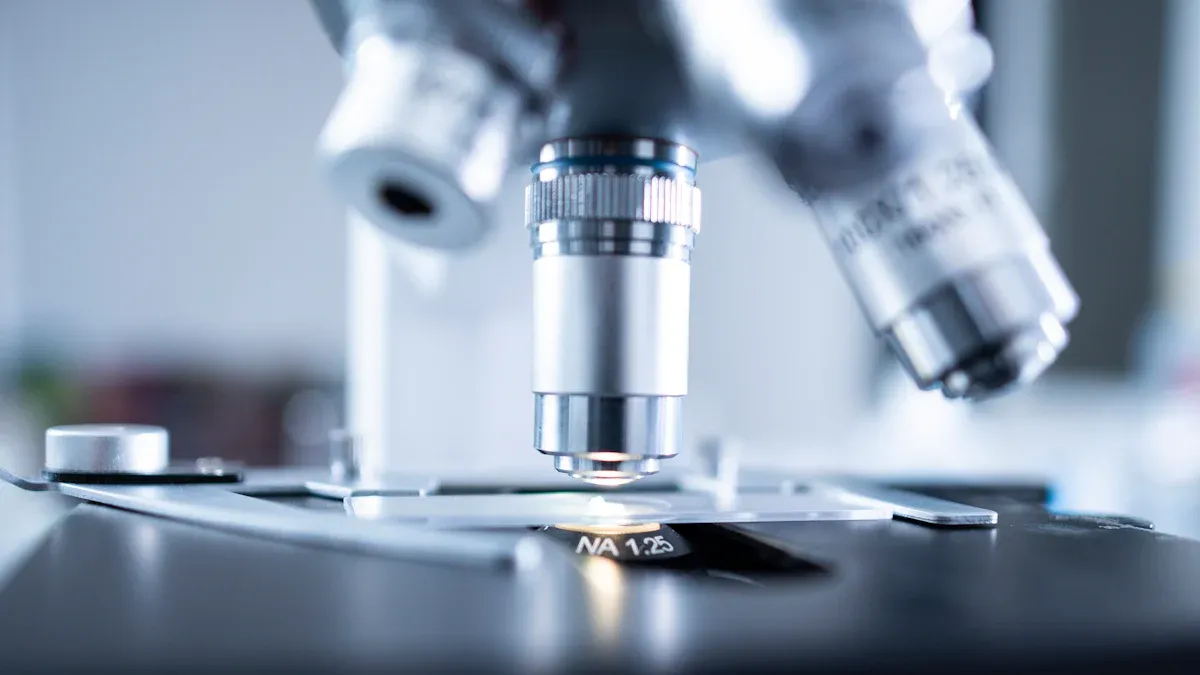Exploring the Latest Breakthroughs in Electro-Optical Systems

Recent improvements in electro-optical technology are impacting numerous sectors. The electro-optical systems market is projected to expand from $12.06 billion in 2023 to $18.8 billion by 2033, reflecting an annual growth rate of 4.5%. This growth is driven by increasing defense requirements and advancements in technology. New electro-optical systems enhance safety, security, and surveillance applications. As you explore these electro-optical systems, you'll see their potential to transform the future of various industries.
Key Takeaways
Electro-optical systems are growing quickly. The market will rise from $12.06 billion in 2023 to $18.8 billion by 2033. This growth is due to defense needs and new technology.
New sensor technologies make images clearer. They also help detect things better, which is important for healthcare and security.
Artificial intelligence helps electro-optical systems work better. It processes data faster, improves object detection, and makes work easier for operators.
Electro-optic polymers and nanomaterials are changing telecommunications. They allow faster data transfer and better performance in many uses.
Electro-optical systems are changing fields like defense, telecommunications, and healthcare. This leads to better safety, efficiency, and communication.
Advancements in Sensor Technology

Enhanced Imaging Capabilities
New changes in sensor technology have created better designs. These designs use high-resolution imaging. For example, the Black Hornet 4 camera has improved a lot. Its resolution went from 160-by-120 pixels in the Black Hornet 3 to 640-by-512 pixels now. This is a 16 times better resolution. It helps you take clearer and more detailed pictures.
Performance Metric | Description |
|---|---|
Gives clearer and more detailed pictures. | |
Enhanced Sensitivity | Helps detect things better in low light. |
Improved Signal Processing | Makes images clearer and better quality. |
Thermal Imaging | Lets you see images based on heat. |
Multispectral Imaging | Collects data from different wavelengths. |
These improvements help you diagnose medical issues better. Better imaging systems are very important in healthcare. They help with better diagnosis and treatment plans.
Improved Sensitivity and Range
New technology is also making sensors more sensitive and able to see farther. For instance, switching from old materials like mercury-cadmium telluride to strained layer superlattice (SLS) allows for smaller pixels. This change greatly improves performance.
You will also notice better detection range. New technology lets sensors find threats 50% farther away than before. This makes them more effective in many uses, like checking the environment.
Smaller pixel sizes allow for bigger focal plane arrays. This helps with awareness and long-range performance.
The camera's resolution change from 160x120 pixels to 640x512 pixels gives 16 times better resolution. This makes it easier to identify objects.
These new electro-optical technologies are changing how you see the world. They make it safer and more efficient.
Combining Artificial Intelligence
Artificial intelligence (AI) is very important for improving electro-optical systems. You can see AI used in many areas, especially for processing data.
AI-Driven Data Processing
Machine learning helps electro-optical sensors work better. These programs improve how objects are detected quickly and with little delay. This helps operators focus on important tasks. AI also removes noise from sensor data. This makes images clearer and less distorted. As a result, you get better awareness of what’s happening around you.
AI helps handle large amounts of data from modern sensors.
Algorithms can automatically find targets based on their features.
Higher dynamic range in sensors means AI helps operators manage lots of data.
Smart Electro-Optical Systems
Smart electro-optical systems make many tasks easier, especially in defense. These systems help find threats, making military work faster. For example, automation helps make quick decisions in urgent situations.
Evidence Description | Source |
|---|---|
AI allows for fast object detection, helping operators identify targets and reducing their workload. | |
New signal processing leads to automatic target finding and better image quality. |
In self-driving cars, AI helps with navigation and safety. These cars use electro-optical sensors to understand their surroundings. With AI, they can quickly process data and make decisions to keep passengers safe.
The mix of new electro-optical technologies with AI is a big step forward. You can expect these systems to keep getting better, leading to more advanced uses in different fields.
Development of New Materials
Electro-Optic Polymers
Electro-optic polymers are changing telecommunications. These materials can control light very well. They have many benefits compared to older materials. For example, they can handle wide optical bandwidths. Some polymer modulators can reach 150 GHz. In contrast, traditional semiconductor modulators only reach 20 to 60 GHz. This ability allows for faster data rates, which are important for modern telecommunications, like 1.6 Tbit/s.
Key Benefits of Electro-Optic Polymers:
Great performance for optical networking.
Better modulation because of aligned chromophores.
More reliable and effective in different uses.
These improvements in electro-optic polymers help data transmission a lot. As you learn about these technologies, you will see how they can change communication systems.
Nanomaterials in Electro-Optics
Nanomaterials are another exciting part of electro-optical systems. New ideas in material science improve sensor performance. For example, strained layer superlattice (SLS) materials allow for smaller pixels. This change leads to better resolution and sensitivity in sensors.
You can look forward to better high-operating-temperature detectors using SLS materials. These advancements boost sensor abilities and widen their use in many industries.
Emerging Trends in Nanomaterials:
Very fast modulation at low power.
Move to high-operating-temperature detectors.
Better cooling technologies for improved sensor performance.
As you explore new electro-optical technologies, you will see how these materials are shaping the future of many fields.
Applications Across Various Sectors
Defense and Security
Electro-optical systems are very important for defense and security. They help with surveillance technologies that improve awareness. For example, advanced thermal imaging systems let you see threats in the dark. The National Reconnaissance Office is looking for ready-made solutions for hyperspectral imaging. This technology was crucial during the conflict in Ukraine. It helped gather important information about enemy movements using satellite data.
The surveillance and reconnaissance part made up 46.54% of the military electro-optical and infrared systems market in 2023.
The military electro-optical and infrared systems market grows because of the need for real-time data and better night vision.
These improvements help military and defense work effectively and quickly.
Telecommunications
In telecommunications, fiber optics greatly improve internet services. You get faster and more reliable internet because of these changes. The need for high-speed internet pushes the use of fiber optics, especially for things like video streaming.
Industry/Application | Contribution to Telecommunications Infrastructure |
|---|---|
High-Speed Internet Demand | Encourages the use of fiber optics to meet the need for quick data transfer in video streaming. |
Smart City Initiatives | Fiber optics are key in expanding internet services, like in Verizon's Fios network. |
Telehealth Services | Healthcare uses fiber optics to improve access to medical care. |
These changes in the electro-optical system market make your online experience better.
Healthcare
Electro-optical technology is changing healthcare too. Diagnostic tools using these systems help find medical issues more accurately. For instance, advanced imaging techniques give clearer views of internal organs. This leads to better treatment plans.
New therapeutic uses for electro-optical systems are coming up, offering fresh treatment methods.
Combining these technologies improves patient care and results.
As you learn about these advancements, you will see how electro-optical systems are changing the future of healthcare.
Recent improvements in electro-optical technology are changing many industries. The market for these systems is expected to grow from $12.06 billion in 2023 to $18.8 billion by 2033. This means a yearly growth rate of 4.5%. This growth comes from the need for better safety and surveillance, especially in defense.
Important uses include intelligence, surveillance, target finding, and reconnaissance (ISTAR). These areas are very important for military work. As you look forward, new electro-optical technologies will keep changing how you see the world.
You should support ongoing research and innovation in this area. The future has exciting chances to improve safety, efficiency, and communication in many fields.
FAQ
What are electro-optical systems?
Electro-optical systems mix electronic and optical technologies. They change light signals into electronic signals and the other way around. You can find these systems in imaging, telecommunications, and defense.
How do laser radar systems work?
Laser radar systems use laser beams to find objects. They measure how long it takes for light to bounce back after hitting an object. This helps you figure out distance and speed accurately.
What is active electro-optical sensing?
Active electro-optical sensing uses light sources to light up targets. This method helps detect things better in different conditions. You can see it used in surveillance and checking the environment.
What are the benefits of high-performance optical materials?
High-performance optical materials make images clearer and more sensitive. They help with better light transmission and last longer. You get clearer images in areas like medical imaging and telecommunications.
How does next-generation optical networking enhance data transmission?
Next-generation optical networking uses new technologies to boost data transfer speeds. This means faster internet and better reliability. You enjoy improved connectivity for streaming and online activities.